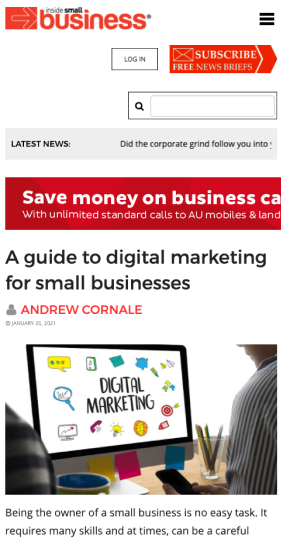Being the owner of a small business is no easy task. It requires many skills and at times, can be a careful balancing act. When your time is consumed by so many other aspects of the business, it can be easy to let marketing drop off. In our experience, we’ve seen this happen for a number of reasons, namely; budget, time and talent. So let me share this with you; digital marketing does not need to be a sophisticated, expensive and time-consuming task. In fact, small-business owners can get their business online and begin interacting with customers in just three simple steps.
Use free website builders
One of the biggest pain points for small-business owners is the creation of a website. It’s often seen as a huge task that they feel under-qualified for yet lack the budgets to do professionally, and it can quickly become an overwhelming task. Let me stop you there.
Unless you’re planning on building a huge multi-functional e-commerce store, building your own website is entirely possible to do yourself. Most small businesses just need a basic website to showcase their products and services. In this case, a full marketing and web development team is unnecessary. Instead, free website builders like Squarespace and WIX are great, and they only require a small subscription fee. They even have templates available so you don’t need to worry about having an eye for design. They also include tutorials on how to add and remove elements, meaning no skills are required to get started.
Utilise Google My Business
Google My Business is yet another free tool that small business owners can take advantage of. It provides a local listing for your business, meaning that it can increase the visibility of your brand when people are searching for you within the area. It’s very simple to set up:
- Go to: https://www.google.com/intl/en_au/business/
- Select manage now.
- Type in your business category.
- Fill in as many of the remaining fields as possible, including; address, where you service, photos, opening hours, etc. Note that this won’t be publicly visible until it’s been verified by Google (next step).
- Once done, Google will send you a postcard to verify the business. You’ll need to input the code from the postcard into Google and then you’re good to go!
Reviews: how to get them, respond and amplify them
Now that you’ve got a Google My Business account, invite your customers to leave a review on it. This can be as simple as sending an email to your database or handing out postcards with instructions on how to do it. Once you start receiving reviews, make sure you respond to all of them – even the not so good ones. Existing customers love to see owners giving their time to say thanks and new customers love seeing a responsive and caring business owner.
Reviews aren’t limited to Google, you can encourage your customers to leave reviews on Facebook too. Depending on the service you offer, some customers may choose to upload a photo to their own socials and tag the brand. This is typically seen in the beauty and hospitality industry but it’s not limited to those only. If this is what your customers are doing, then don’t waste the opportunity! Be sure to interact with their post by liking and commenting, or if it’s a story, then repost it to your brand’s one.
Getting your business online may feel like a big task, but in reality, there is a sea of things small businesses can be done without investing huge amounts of time and money. For simple tasks, free resources like Google My Business and website builders are great. They reduce the need for hefty spend and don’t require a plethora of skills…perfect for busy professionals!



